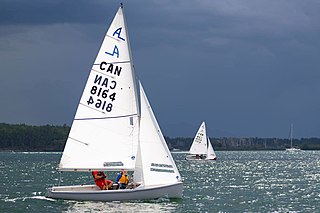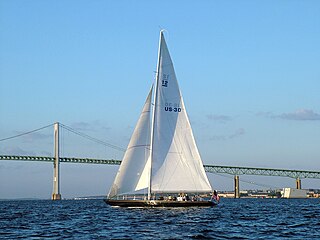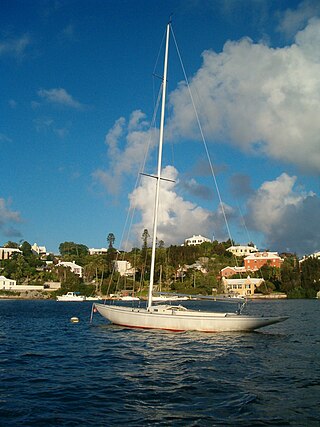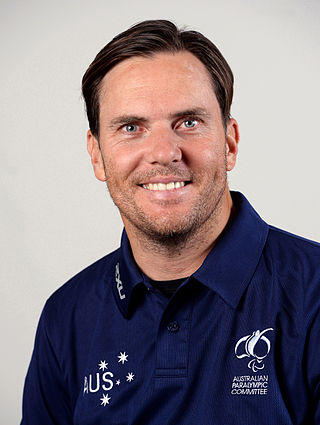
Dinghy racing is a competitive sport using dinghies, which are small boats which may be rowboats, have an outboard motor, or be sailing dinghies. Dinghy racing has affected aspects of the modern sailing dinghy, including hull design, sail materials and sailplan, and techniques such as planing and trapezing.

The Albacore is a 4.57 m (15 ft) two-person planing dinghy with fractional sloop rig, for competitive racing and lake and near-inshore day sailing. Hulls are made of either wood or fiberglass. The basic shape was developed in 1954 from an Uffa Fox design, the Swordfish. Recent boats retain the same classic dimensions, and use modern materials and modern control systems.

World Sailing (WS) is the world governing body for the sport of sailing recognized by the International Olympic Committee and the International Paralympic Committee (IPC).

The Star is a 6.9 metres (23 ft) one-design racing keelboat for two people designed by Francis Sweisguth in 1910. The Star was an Olympic keelboat class from 1932 through to 2012, the last year keelboats appeared at the Summer Olympics.

An iceboat is a recreational or competition sailing craft supported on metal runners for traveling over ice. One of the runners is steerable. Originally, such craft were boats with a support structure, riding on the runners and steered with a rear blade, as with a conventional rudder. As iceboats evolved, the structure became a frame with a seat or cockpit for the iceboat sailor, resting on runners. Steering was shifted to the front.

The 12 Metre class is a rating class for racing sailboats that are designed to the International rule. It enables fair competition between boats that rate in the class whilst retaining the freedom to experiment with the details of their designs. The designation "12 Metre" does not refer to any single measurement on the boat, and is not referencing the vessels overall length, rather, measures the sum of the components directed by the formula which governs design and construction parameters. Typically 12 Metre class boats range from 65 to 75 feet in length overall; they are most often sloop-rigged, with masts roughly 85 feet tall.

The International rule, also known as the Metre rule, was created for the measuring and rating of yachts to allow different designs of yacht to race together under a handicap system. Prior to the ratification of the International rule in 1907, countries raced yachts under their own national rules and international competition was always subject to various forms of subjective handicapping.

The Dragon is a one-design keelboat designed by Norwegian Johan Anker in 1929. In 1948 the Dragon became an Olympic Class, a status it retained until the Munich Olympics in 1972. The Dragon's long keel and elegant metre-boat lines remain unchanged, but today Dragons are constructed using the latest technology to make the boat durable and easy to maintain. GRP construction was introduced in 1973 and the rigging has been regularly updated.

The RS Feva is a two-person sailing dinghy designed by Paul Handley in 2002. It is manufactured and distributed by RS Sailing. The RS Feva is an International Sailing Federation (ISAF) International Class, a Royal Yachting Association (RYA) Supported Junior Class, and has been selected by the Dansk Sejlunion and Norges Seilforbund for major sailing growth projects.

The International One Design is a class of sail boat developed in 1936 for yacht racing. It is a 33-foot open-cockpit day sailer used for day racing, rather than for overnight or ocean races. Popularised prior to the Second World War, the International One Design class is considered a classic one today.

The International Six Metre class is a class of classic racing yachts. Sixes are a construction class, meaning that the boats are not identical but are all designed to meet specific measurement formula, in this case International rule. At their heyday, Sixes were the most important international yacht racing class, and they are still raced around the world. "Six metre" in class name does not, somewhat confusingly, refer to length of the boat, but product of the formula; 6mR boats are, on average, 10–11 metres long.

The SKUD 18 is a class of racing sailing boat. It is a lead-assisted skiff with a tube-launched asymmetrical and a modern high performance stayed rig. The boat was created for trials held by the International Association for Disabled Sailing who were looking for a new two person boat for an additional medal allocated to sailing for the 2008 Paralympics.
The International Association for Disabled Sailing (IFDS) was an affiliate member of the International Sailing Federation and was responsible for coordinating the paralympic sailing competition with the International Paralympic Committee. The organisation was initially called the International Foundation for Disabled Sailing up until around 2008 when it had to change its name due to tax law in the country it is registered in.

Daniel Fitzgibbon, is an Australian Paralympic sailor, who won a silver medal at the 2008 Summer Paralympics in Beijing. He won gold medals at the 2012 London and 2016 Rio Paralympics with partner Liesl Tesch in the two person SKUD 18.

Matthew Bugg is an Australian sailor. He represented Australia at the 2012 Summer Paralympics in the 2.4mR class sailing event. He won a bronze medal at the 2015 IFDS World Championships. He won a silver medal in the 2.4mR at the 2016 Rio Paralympics.

The Wētā 4.4 Trimaran is a 4.4 metre sailing dinghy conceived and developed in New Zealand from 2001-2006 by Roger and Chris Kitchen and others with original drawings by TC Design's Tim Clissold.
The Para World Sailing Championships is an annual World Championship multi-class sailing regatta in para classes organised by the World Sailing.
Cherrie "Cherry" Samonte Pinpin, is a Filipina Paralympic sailor who crewed in the SKUD 18 Two-Person Keelboat class, Sailing at the 2008 Summer Paralympics, Beijing.
The 2.4 Metre World Championship is an annual international sailing regatta of 2.4 Metre keelboats, organized by the host club on behalf of the International 2.4mR Class Association and recognized by World Sailing, the sports IOC recognized governing body.


















